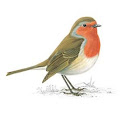While living in Belgium, I enjoyed exploring the endless varieties of its greatest cultural exports, including chocolate, beer, frites, and gaufres--oh, and believe you me, I have the extra curvy hips to prove my anthropological thoroughness--but I had until not long ago been largely ignorant of another great Belgian phenomenon: the bande-dessinée. (Also known as BD, or, for those anglophones among us, the comic book.)
The crown jewels of Belgian BD are the beloved characters Tintin, the intrepid boy reporter, and Milou, his fluffy white sidekick. I was vaguely aware of these personages--living there it's not easy to remain completely in the dark--but had never read a Tintin comic, nor ever had much desire to do so. Having lived in Europe for some time and in various countries, I was also aware that Tintin was a pan-European figure, universally adored, and whose books are more or less required reading for all European children. Created by Georges Remi, aka Hergé, Tintin might be compared most closely to a comic-book version of Hardy Boys, especially because of his retro knickerbockers and crime-solving skills, but he and his clever dog sidekick invite comparisons to Timmy and Lassie, or Shaggy and Scooby-Doo, or Dorothy and Toto.
So for my birthday last May, when I was given a charming small-format version of episode number 7 in Tintin's adventures, "Le sceptre d'Ottokar," or Ottokar's scepter, I decided to take the plunge into the world of Belgian comic books. Tintin travels to Moldavia, an invented Eastern European country, where he of course saves the day from an attempted coup. I have since purchased "Tintin in America" as I was curious to see what happens to the poor guy when he gets mixed up with gangsters, and also to see exactly what myths of Americana would be pulled out of Hergé's hat.
It's a great way to practice my French (yes, back to picture-book stage, especially useful for learning action verbs!) and get on the cultural bandwagon so I'm not in the dark when it comes to European conversations. I will probably have to read and/or watch some Asterix and Obelix, as well.
During the summer I visited the Comic Book Museum, of which a portion is dedicated to the mythology and creation of Tintin, and the comic books are a fascinating look into the sociology and geopolitics of Europe (sort of in the same way that the bad guys in James Bond movies changed before and after the Cold War, Tintin's adventures around the world always have an implied political slant). Indeed, comic books are taken rather seriously by French scholars and are considered "le neuvième art," the ninth art. As wikipedia points out, "It is not insignificant that the French term contains no indication of subject matter, unlike the American terms "comics" and "funnies", which imply an art form not to be taken seriously."
Although there's a comic-book store every five paces in Brussels, I've never been attracted visually to the more dense and quite "adult" series that are most prevalent. Tintin suits me just fine; I like the bright colors and sturdy forms, the linear adventures that pause with a cliffhanger every couple of pages.
All of this is to say: on my (long) list of things to bring back with me from Brussels when I visit next week, another installment (or two) of those cute small-format Tintin books is at the top.
03 December 2008
Tintin
Subscribe to:
Post Comments (Atom)

1 comment:
Very interesting! I love the factoid about the French referring to comics as "the ninth art". Strikes me as appropriate. I used to babysit for two boys whose father lived a few years in Belgium as a child. They have many of these old Tintin books from the 70s and we could read them for hours.
Post a Comment